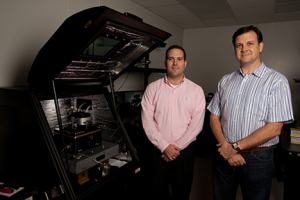More than three billion people – almost half of the world’s population – are at risk of contracting malaria, which is spread by infected mosquitos.
In 2013, an estimated 200 million malaria cases worldwide resulted in approximately 585,000 deaths of mostly African children under the age of 5, according to the World Health Organization.
Last month, the Proceedings of the National Academy of Sciences of the United States of America, a scientific journal established in 1914, published results of a groundbreaking malaria study conducted by professors and graduate students in the Cullen College of Engineering at the University of Houston.
Jeffrey Rimer, Ernest J. and Barbara M. Henley assistant professor of chemical and biomolecular engineering, and Peter Vekilov, professor of chemical and biomolecular engineering and chemistry, developed a technique that can help facilitate development of new antimalarial drugs.
The UH engineers discovered the fundamental mechanisms for hematin crystal growth and drug-induced crystal inhibition in malarial parasites. Their research also yielded potential for accelerating high-throughput combinatorial drug screening, a shot-in-the-dark approach to drug development.
The project began three years ago with seed funding from the Alliance for NanoHealth at the Methodist Hospital Research Institute in the Texas Medical Center. Rimer and Vekilov enlisted the help of two graduate students, Katy Olafson and Megan Ketchum.
“Not many researchers are looking at malaria with the same set of techniques and approaches we are bringing to bear,” Rimer said. “To this end, we feel that we can make a significant contribution to this field of research.”
The malaria parasite, which is transmitted by mosquitoes, goes through several stages in its life cycle after it enters the human body. During the asexual stage, the parasite infects red blood cells and breaks down hemoglobin, releasing heme. Heme is then oxidized to toxic hematin, which crystallizes within the digestive vacuole, thereby removing the toxin from the parasite.
While the quinoline class of antimalarials has proven effective, fundamental knowledge of hematin crystallization and the mechanism by which antimalarial drugs potentially inhibit crystallization were not well understood until Rimer and Vekilov conducted their study. This lack of understanding among scientists was attributable to their inability to conduct in situ studies of crystal growth at the microscopic level.
Consequently, the first objective of the UH study was to develop a biomimetic platform for assessing hematin crystallization. Rimer, Vekilov and their students used time-resolved atomic force microscopy, AFM, to render three-dimensional topographical images of crystal surfaces at near-molecular resolution. They discovered a method of growing hematin crystals that is similar to those formed in vivo, and published their breakthrough last year in Crystal Growth and Design, a journal of the American Chemical Society.
“It was exciting to identify a growth solution that was capable of producing hematin crystals similar to those observed in parasites,” Rimer said. “This biomimetic growth solution became an enabling platform for our AFM study.”
Rimer and Vekilov conducted the first-ever in situ AFM study of hematin crystallization in the absence and presence of a common antimalarial drug, chloroquine. The UH team observed that hematin grows by a classical pathway involving the generation and spreading of layers via the incorporation of hematin molecules. They identified four types of crystal surface sites for hematin to incorporate into the crystal. They also quantified the rate of layer generation and the velocity of layer advancement as a function of growth conditions, such as hematin concentration.
In situ AFM revealed that a two-micromolar concentration of chloroquine – an amount almost 100 times less than the solubility of hematin – suppresses the growth of layers on crystal surfaces. The drug concentration disproves a popular hypothesis that complexation, which involves the binding of an antimalarial drug molecule to free hematin in solution, is the primary mode by which the drug arrests hematin crystallization. While drug-hematin complexes do exist, this mode of action would require a significantly higher and toxic concentration of drug to achieve the same effect they observed for crystal growth inhibition, Rimer said.
The research validates another hypothesis that antimalarial drugs bind to crystal surfaces and block the attachment of hematin. This leads to the accumulation of toxic hematin in the digestive vacuole that ultimately kills the parasite.
“In essence, the parasite commits suicide by generating this toxin without a way of removing it,” Rimer said.
Elucidating the effects of molecules on hematin crystal growth could help pharmaceutical companies better streamline efforts to design and screen new antimalarial drugs. The UH team’s findings could also potentially accelerate high-throughput combinatorial drug screening, which is effective but time consuming. Researchers could prescreen the effects of numerous molecules on crystal growth to narrow the pool of potential drugs from thousands to hundreds before conducting more intensive parasite assays. Rimer and Vekilov have filed a provisional patent application for this technique.
“Identifying potential applications for our work is where our engineering mindset comes into play,” Rimer said. “We are always thinking about the practicality of our research, and in this particular case, we believe our method of assessing hematin crystallization can help facilitate the development of new antimalarial drugs.”
